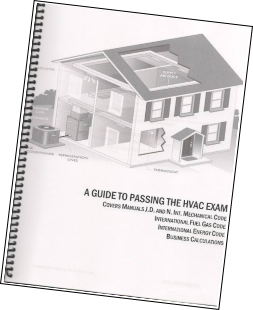


“Guide to Passing the Michigan HVAC Contractor’s Licensing Exam”
Completely up-to-date through 2017
G Contractor’s Licensing Exam”
“I guarantee you will pass your HVAC license exam, or your money back!"
This copyrighted home study HVAC licensing course teaches and explains the provisions of the Mechanical Code, Fuel Gas Code. Manuals J and N load calculations, Manual D duct design and business principles. it is designed to assist you in understanding the tough stuff; the stuff many examinees struggle with on the exam.
WHAT YOU WILL LEARN WITH OUR GUIDE
- Mechanical Code-
What to highlight and how to calculate ventilation and combustion air requirements, hood sizes and return air ducts, plus more - Fuel Gas Code-
What to highlight. Determining confined spaces, gas pipe sizes, vent sizes and clearances, plus more - Manual J, 8th edition-
Easy to understand procedures for calculating loads . Basic principles of heat transfer and thermodynamics. Operating cost calculations - Manual N-
Once we get through Manual J, N will be a cakewalk. - Manual D-
"Three easy steps to duct sizing." - Symbols and Psychrometrics -
How to read and use charts and calculate A/C capacity - Business-
Learn business equations and accounting principles. Find out how to figure profit the correct way. - Energy Code-
Only what you need to know to pass. - 150 Strategic Practice Questions-
Answer these and you'll surely pass - Much, much more
Below Is a sample of what you may encounter on the exam.
- Is an 80,000 btuh gas furnace installed in a 20' x 18' room considered in a confined space?
- Can you calculate the required outdoor ventilation rate for a 1700 sq. ft. office?
- When installing a gas water heater, with an 18 ft. high chimney vent, should you select the 15 Ft. or 20 Ft. row, on the vent sizing charts?
- Calculate the velocity (fpm) of 800 cfm in an 8" x 14" duct.
- If R-
19 insulation is added to a ceiling with a U- value of .05, what is the new R- value? New U- value? - If you purchase a fixture for $1000 and wish to make 30% profit; what would your selling price be? Hint: the answer is not $1300. Scroll to the bottom for answer to this question.
Students who have used this guide book have a higher passing rate than students who take a classroom course. WHY? Because people who READ the material retain much more than people whom are TOLD the material, and the Guide is always next to them as a reference to refer to later.
We make learning easy
Once you've read our sections on load calculations and duct design you'll be looking for a butt kicking machine for not ordering our course earlier. There is simply no easier method for fully understanding these manuals.
Because many states are now adding business questions to their HVAC exams, we have included a section on business practices and math. It is written in a language, we in the trade understand. You no longer have to have the skills of a Philadelphia lawyer, mathematician and a CPA to help prepare for the exam.
BELOW IS AN EXCERPT FROM THE GUIDE TAKEN FROM OUR SECTION ON MANUAL J (load calculations)
R-
This is a number indicating the ability of a substance to resist the flow of heat. The higher the R value, the better it acts as an insulator.
Typical R-
U value
(Learn and understand U value. It is the foundation of a load calculation.)
The U value is the number of BTUs that pass though one square foot of substance in one hour’s time when there is one degree temperature difference. The U value is the reciprocal* of the R value. A U-
U=1/R
*A reciprocal of a number is 1 divided by the number. The reciprocal of 20 is 1/20 or .05.
Suppose you had a six-
U= 1/R
U= 1/19
U=.0526
Therefore, .0526 BTUs pass through 1 square foot of the batt each hour when there is one degree temperature difference.
If the batt measured 2’ x 8’ we would have a total area of 16 sq. ft. We could then say that .8414 BTUs (16 sq. ft. x .0526 BTUs). Pass through the entire batt in one hour when there is one degree temperature difference.
Carrying our example just one step further, if the temperature on one side of the batt is 20 degrees and on the other side it is 70 degrees, then we would have a 50-
Simply stated, use the following formula to determine the amount of heat gained or lost through any substance:
BTUH = U x TD X AREA
=.0526 x 50 X 16'
= 42.08
Once you know the U value, the square footage and the temperature difference, you can calculate the BTU heat loss or gain per hour through a substance. However, walls, floors and ceilings are not made up of just insulation. A wall may be made up of brick, sheathing, insulation and sheetrock, each of which has its own R value. The R value of each component must be added together to obtain the total R value. Then we simply take the reciprocal (1/R) and get the total U value of the wall. For a list of R-
http://www.coloradoenergy.org/procorner/stuff/r-
John,
I would like to inform you that I passed my exam (Master of HVAC). Your internet system was very good, I think your knowledge and quick responses were a part of my success. From here, I would like to shake your hand.
Thanks again;
Arvin A. K.
AN EXCERPT FROM THE GUIDE TAKEN FROM OUR SECTION ON THE FUEL GAS CODE
Single appliance -
What size B vent is needed for a 160,000 BTUH, naturally ventilated appliance if the total vent height is 18’ and the lateral 2’?
Under the height column you have to choose either 15’ or 20’. Remember this. The taller the vent the more capacity it has, therefore, if the 20’ row is used the vent may be under sized. Always use the shorter height. In this case use 15’. Now use the 2’ lateral and select a vent size under NAT. A 5” vent will handle only 150,000 BTUH, while a 6” vent will handle 225,000 BTUH, therefore select a 6” vent.
“YOU WILL LEARN MORE FROM THIS GUIDE THAN FROM ANY FORMAL CLASSROOM COURSE AND IT IS ONLY $149”
My Guarantee
YOU WILL LEARN MORE FROM THIS BOOK THAN FROM ANY CLASSROOM COURSE AND YOU WILL PASS YOUR EXAM OR WE WILL REFUND YOUR PURCHASE PRICE IMMEDIATELY. JUST SEND US AN E-
energymarketingservice@gmail.com
Get all the courses needed to pass the exam
FOR ONE LOW PRICE
Mechanical Code Course -
Manual D Course -
Energy Code Course
PURCHASE INSTANT DOWNLOAD
ONLY $149
When your payment has been verified, a link will appear on your computer screen. Click on the link and the guide will automatically download to your computer, tablet, smart phone or reader. The Guide may be saved or printed out and referred to as many times as you wish
Your debit or credit card purchase will be safely processed through ClickBank
PURCHASE
HARD COPY
ONLY $169 (includes S+H)
To order a hard copy of our course, simply click on the BUY NOW button below. You will receive the your course within 3-
Your debit or credit card purchase will be safely processed through PayPal
OR
Answer to profit question: $1428.57. Learn how and why with our “Guide to Passing the HVAC Exam”
Have questions?
Energy Marketing Service
call 252-
CONTACT US anytime by email


HVAC licensing prep course
"If you don't do it now, what will you be doing five years from now?"
After spending hours in a cram course, listening to an instructor rushing to explain the provisions of all the code books, plus teaching you how to perform load calculations and size ducts, vents and piping and then covering business and accounting principles, the average attendee will come out of the class with one thought on his mind; "What did he say?" I know, as I have been on both sides.
Believe me, the Guide is the way to go!
About your instructor
John White has been teaching plumbing and mechanical for over 40 years. He has a BSBA degree in Business Administration, holds an electrical, plumbing and HVAC licenses. He has taught at both, universities and community colleges, has presented seminars throughout the nation and has even created licensing exams like the one you are about to take. John’s son took over his mechanical contracting business in 2006, allowing him to devote his energy to his consulting company, Energy Marketing Services, which develops and conducts plumbing and HVAC exam prep courses and is also an approved provider of continuing education.


#1 self study HVAC course

John White
course instructor
Eliminate weeks of study time
ENERGY MARKETING SERVICE
SERVING HVAC AND PLUMBING CONTRACTORS SINCE 1986
SERVING HVAC AND PLUMBING CONTRACTORS SINCE 1986


“So easy, your dog can do it!”
EMS
